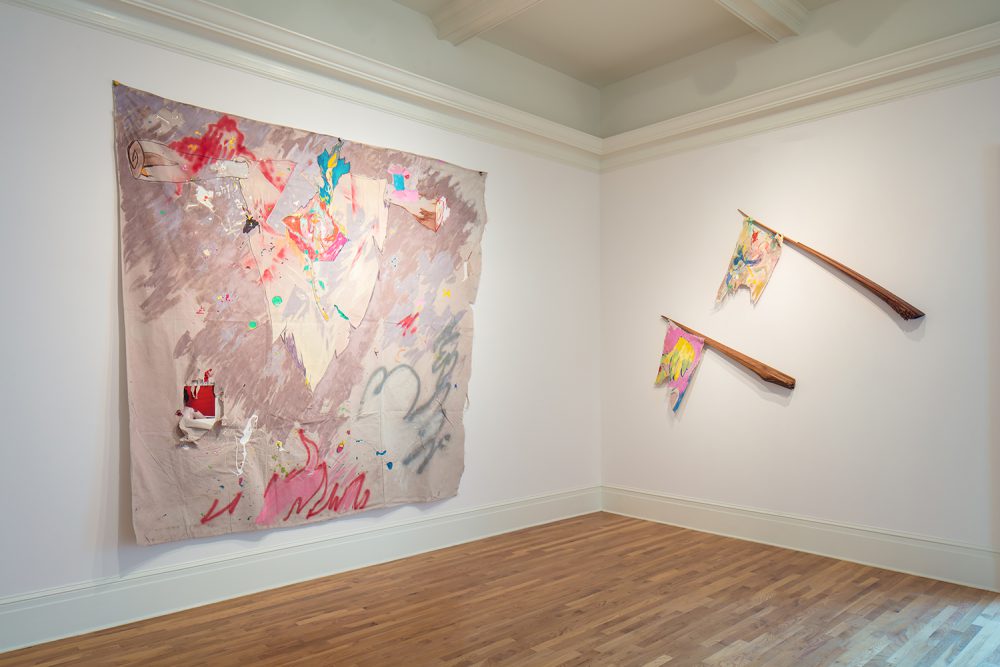Exhibition Pick: “Beyond the Canvas: Contemporary Art from Puerto Rico”
Charlie Tatum visits the Newcomb Art Museum of Tulane University’s latest exhibition, which presents the work of five Puerto Rico–based artists.

Installation view of works by Pedro Vélez in “Beyond the Canvas: Contemporary Art from Puerto Rico” at the Newcomb Art Museum of Tulane University, New Orleans. Photo by Jeffery Johnston.
“Beyond the Canvas: Contemporary Art from Puerto Rico”
Newcomb Art Museum of Tulane University
Woldenberg Art Center
April 26–July 9, 2017
“Beyond the Canvas: Contemporary Art from Puerto Rico” is disorienting at first. The works by the five artists featured—who are all based in Puerto Rico—are visually disparate and clash with their various styles and color palettes. The dense picture planes of Arnaldo Roche Rabell’s iconographic frottages filled with leaves, ladders, and body parts at first feel out of place alongside Elsa María Meléndez’s ripped, reassembled, and painted stuffed animals and, even more so, in sight of the smooth curves formed by Zilia Sánchez’s three-dimensional stretcher frames. And while these artists’ practices are formally linked by their “challeng[ing] the notion of the canvas as a flat surface,” the exhibition’s strongest assertion is that there is no singular Puerto Rican aesthetic—a still important point of resistance within a long lineage of Eurocentric museums’ limiting our collective understanding of “non-Western art” by naming it as something distinct (“primitive,” “craft,” “artifact”) from the trajectory of art history otherwise taught in schools.
In fact, many of the artists in “Beyond the Canvas” complicate a relationship to Modern painting through acts of quotation and subversion. In a video on view, Sánchez throws one of her undulating artworks into the sea, taking her practice out of the studio and into the world. With her Amazonas, Sánchez embraces feminine forms by imagining each geometric painting as a body with nipple-like protrusions, their titles perhaps referencing the Greek myth of the Amazons as a group of warring women who chopped off their own breasts to better wield bows and arrows. Julio Suárez uses the forms of Minimalism in his stark, monochromatic paintings to present his explorations of the nearly unseen labor of his careful brushstrokes and the gentle folding of his shaped canvases into delicate ridges. Sánchez’s and Suárez’s works are reminders of the rich history of geometric abstraction in Latin America, a legacy spotlighted by the recent, high-profile retrospectives of artists like Lygia Pape, Hélio Oiticica, Lydia Okumura, and Lygia Clark.
Pedro Vélez explicitly addresses representation in his practice both as an artist and an art critic, demanding equity across the entire infrastructure of the art world—artists, curators, critics, and others. His Surrender Flag with Dollar Skull, or Surrender Flag with Zombie Abstraction, 2015, appears as a sort of battle standard in the face of a whitewashed art market that has embraced a brand of politically neutered, highly salable abstract painting, many of whose trappings Vélez reworks into his own practice—airbrushed lines, torn canvases, messy brushstrokes. In the context of his insistence on holding arts workers accountable for their own biases, Vélez’s paintings suggest that formal explorations are not necessarily at odds with social forces, politics, and personal experiences, and this is perhaps the exhibition’s greatest takeaway.



